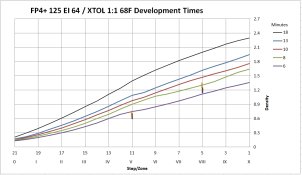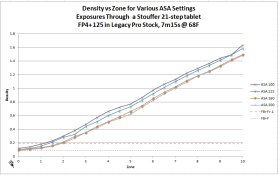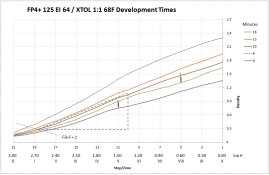tom williams
Subscriber
Greetings.
I wonder if anyone in the know could weigh in on a question about modifying film speed based on tested development times.
Background: A while back I determined an EI of 64 for FP4+ 4x5 film, developed in stock XTOL. A few days ago I exposed 5 sheets of film to a blank white target, in full sun, overlain by a 4x5 Stouffer step tablet, and developed them at times from 6 minutes to 18 minutes. The developer was XTOL diluted to 1:1, in contrast to the development of my speed test sheets with stock XTOL. I've attached a plot of density vs step (or Zone) for the development time test sheets.
I thought I would determine the optimum development time (for FP4+ EI 64 developed in XTOL diluted 1:1) by noting which curve intersected the vertical target bars at Zones V and VIII (the 4 small vertical bars. They cover Ansel Adams' suggested target densities for diffusion (orange bar) and condenser (black bar) enlargers). Obviously that didn't happen with the development times I selected, and I don't want to consider shorter development times than 6 minutes.
The data I used to determine speed indicate a linear progression in density vs exposure in the Zone V through Zone VIII interval, which is what makes me think that I can use these development test data to deduce a reasonably accurate film speed, without resorting to new speed and development time tests. It looks to me like an exposure decrease of 1 stop would bring the 10-minute development line into the range of AA's target densities. Is this a sensible idea?
Any thoughts or suggestions about this approach?
cheers
Tom

I wonder if anyone in the know could weigh in on a question about modifying film speed based on tested development times.
Background: A while back I determined an EI of 64 for FP4+ 4x5 film, developed in stock XTOL. A few days ago I exposed 5 sheets of film to a blank white target, in full sun, overlain by a 4x5 Stouffer step tablet, and developed them at times from 6 minutes to 18 minutes. The developer was XTOL diluted to 1:1, in contrast to the development of my speed test sheets with stock XTOL. I've attached a plot of density vs step (or Zone) for the development time test sheets.
I thought I would determine the optimum development time (for FP4+ EI 64 developed in XTOL diluted 1:1) by noting which curve intersected the vertical target bars at Zones V and VIII (the 4 small vertical bars. They cover Ansel Adams' suggested target densities for diffusion (orange bar) and condenser (black bar) enlargers). Obviously that didn't happen with the development times I selected, and I don't want to consider shorter development times than 6 minutes.
The data I used to determine speed indicate a linear progression in density vs exposure in the Zone V through Zone VIII interval, which is what makes me think that I can use these development test data to deduce a reasonably accurate film speed, without resorting to new speed and development time tests. It looks to me like an exposure decrease of 1 stop would bring the 10-minute development line into the range of AA's target densities. Is this a sensible idea?
Any thoughts or suggestions about this approach?
cheers
Tom








